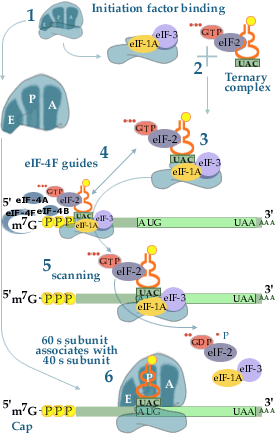Initiation of Translation
The first step in translation
is initiation, in which the proper start position on
the mRNA is identified. Because of the 'comma-less'
nature of the genetic code, only the position of the
initiation codon determines the reading frame, and faulty
initiation might result in complete distortion of the
message as a result of a shift in the reading frame.
Precise initiation is therefore the key to accurate
translation. The genetic code does not include a
specific start signal. Instead, the codon AUG has a
dual function that is coupled to the existence of two
types of methionine-containing tRNAs. One of these
Met-tRNAMets is specifically used during
initiation and is usually referred to as initiator tRNA  . The second
Met-tRNAMet, used only during the
elongation process to specify incorporation of the
amino acid methionine at internal positions in the
protein, is correspondingly referred to as elongator . The second
Met-tRNAMet, used only during the
elongation process to specify incorporation of the
amino acid methionine at internal positions in the
protein, is correspondingly referred to as elongator
 .
Several proteins, initiation factors (eIF, eukaryotic
initiation factors), provide help to the ribosome
during the initiation process. .
Several proteins, initiation factors (eIF, eukaryotic
initiation factors), provide help to the ribosome
during the initiation process.
|
 |
The initiation process can be
divided in several distinct steps.
1. First the ribosome dissociates into its two
constituent subunits,called the 40S and 60S subunits.
The subunits are prevented from spontaneous
reassociation by binding of initiation factor eIF-3
to the small ribosomal subunit.
2. Initiation factor eIF-2 is a GTP-binding protein
that specifically recognises initiator tRNA
( )
forming a ternary complex, )
forming a ternary complex,  . .
3. The ternary complex binds to the 40S ribosomal
subunit.
4. The cap-structure at the 5´end of the
messenger RNA is recognised by initiation factor
eIF-4F. This factor has a subunit that specifically
interacts with the cap-structure (see splicing:
cap-structure).
Binding of the initiation factor guides the activated
40S subunit, containing the initiator tRNA, to the
5´end of the mRNA. This type of initiation is
known as cap-dependent initiation and is the most
common type of initiation. Initiation can also occur
through an alternative cap-independent initiation
mechanism.
5. The mRNA-bound subunit travels along the
5’-untranslated end of the mRNA until it
reaches the first AUG codon that will serve as the
start codon for the translation process. This
process, known as scanning, requires energy (ATP) and
additional initiation factors.
6. When the activated 40S subunit has reached the
start codon, the 60S subunit binds to the 40S
subunit. This reaction requires an additional
initiation factor, eIF-5, which hydrolyses the
eIF-2-bound GTP, thereby releasing the initiation
factors from the ribosome. As a result of the
initiation process, the initiator  becomes positioned in
the ribosomal P-site. becomes positioned in
the ribosomal P-site.
|
